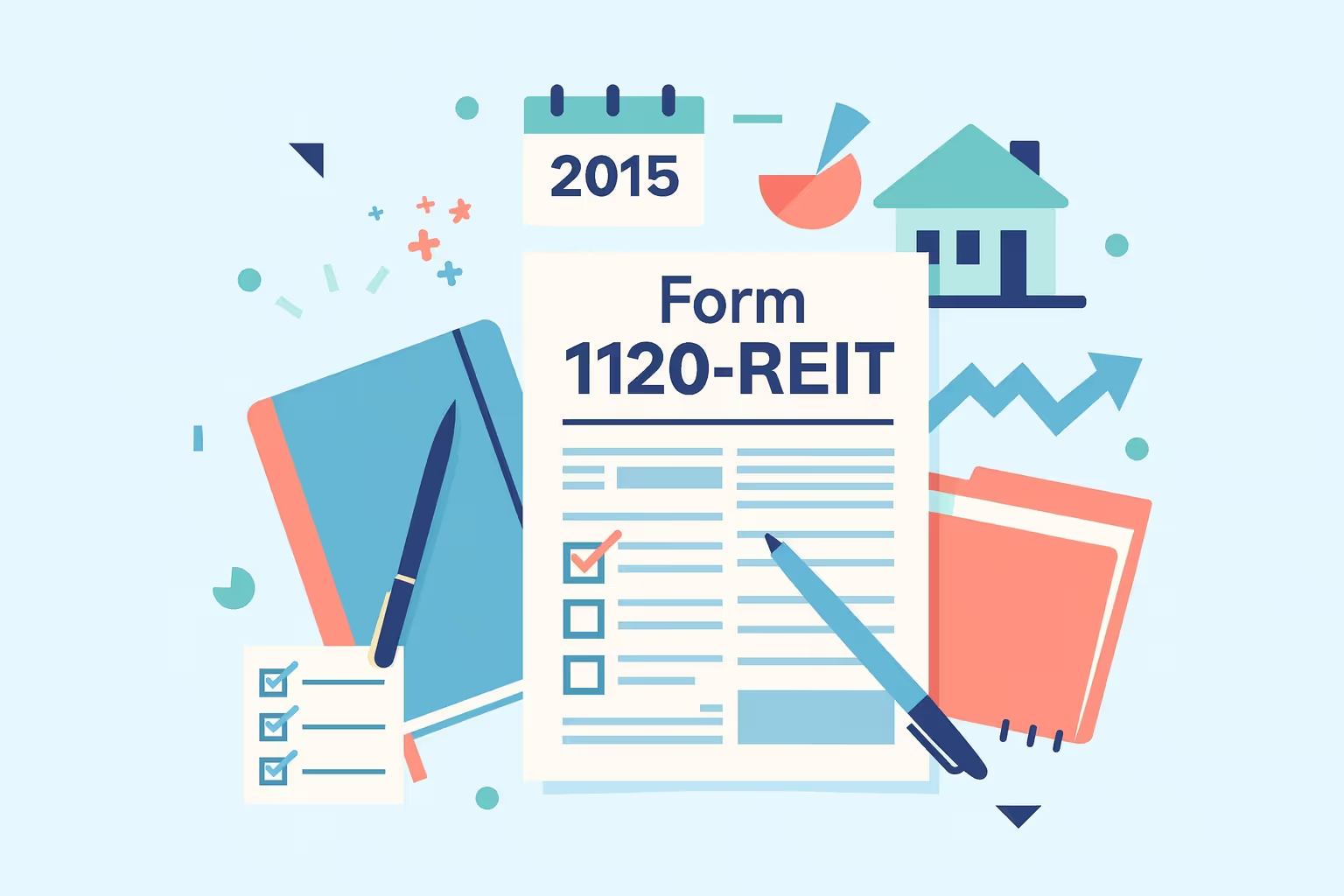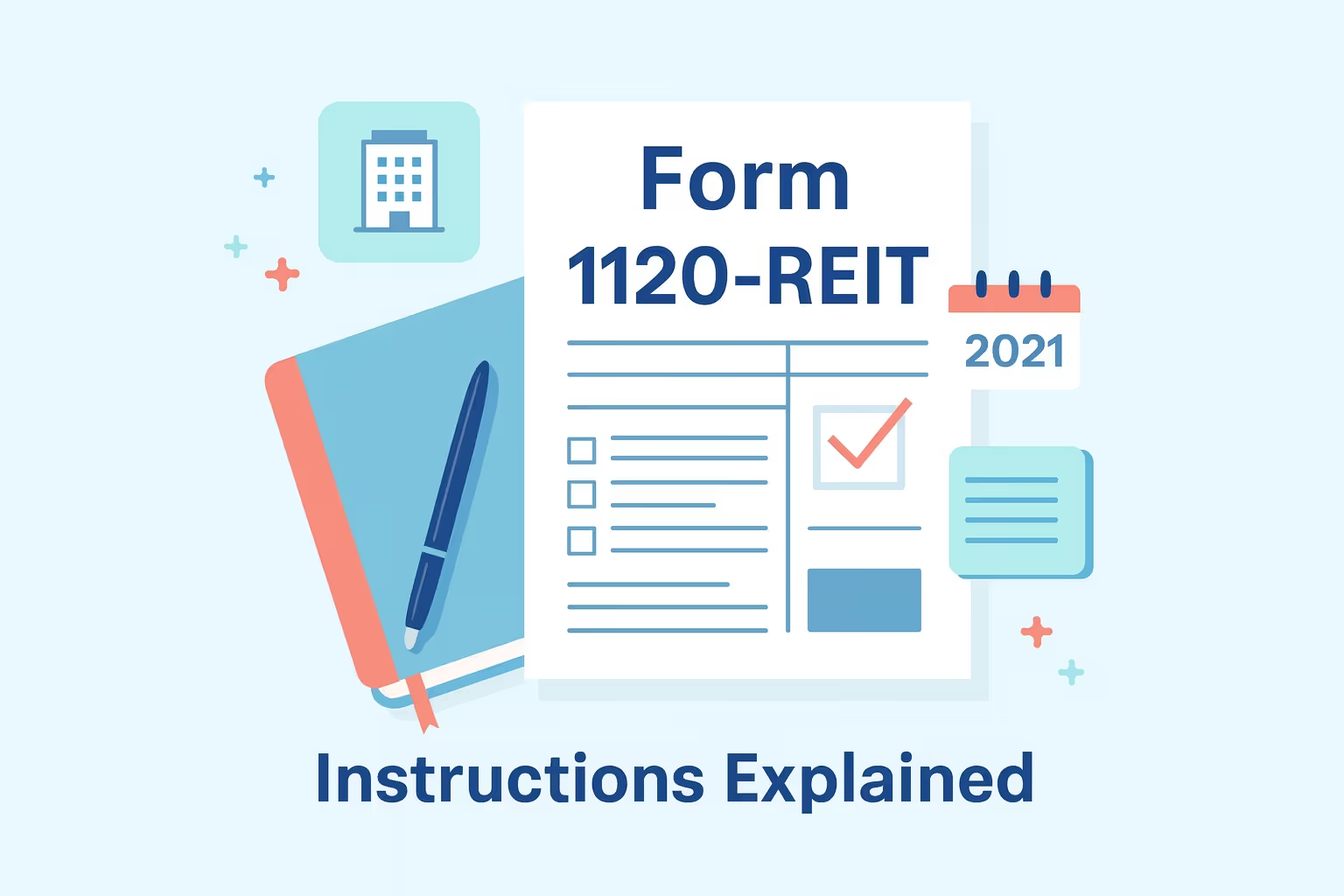
Form 1120-REIT is the federal income tax return used by real estate investment trusts to report income, deductions, and shareholder distributions. For the 2011 tax year, the Internal Revenue Service issued specific filing rules and updates that REITs needed to follow to maintain their tax-advantaged status. Filing this return correctly is critical, as it determines taxable income, ensures compliance with qualification tests, and allows trusts to claim deductions that can reduce or even eliminate corporate-level income tax.
The 2011 filing year included notable changes, such as relief from the built-in gains tax for certain REITs and the introduction of new procedures for updating business addresses. These adjustments highlight how tax law evolves, making it necessary for businesses and individual investors to review the form and its instructions carefully. Properly completing this return requires accurate reporting of ordinary income, capital gains, interest, dividends, and other types of earnings from property or related investments.
This guide provides step-by-step instructions based on the official Form 1120-REIT instructions for the 2011 tax year. It is designed for readers who may be unfamiliar with REIT taxation but need clear information to file correctly. While the focus is on tax year 2011, the article also emphasizes best practices for recordkeeping, compliance, and tax payment. By understanding the filing process, REITs can prevent costly errors and ensure they remain entitled to the benefits of their special tax treatment.
Understanding Form 1120-REIT
Form 1120-REIT is the official tax return that real estate investment trusts must file with the Internal Revenue Service. The form is specifically designed to report income, deductions, shareholder distributions, and other items that determine a REIT’s taxable income for the year. Filing this form is mandatory for qualifying entities, as it is the primary means of remaining compliant with federal tax law.
Who Must File?
A corporation, trust, or association must file Form 1120-REIT if it elects to be treated as a real estate investment trust under the Internal Revenue Code. Once the election is made, the entity must continue filing this return unless it revokes or loses its REIT status. This requirement applies regardless of whether the REIT had high earnings or low activity during the tax year.
Purpose of the Form
The form serves several important purposes:
- It reports income such as dividends, interest, rents from office buildings or other property, and capital gains from the sale of assets.
- It calculates deductions, including the dividends paid deduction, which allows REITs to distribute taxable income to investors without facing corporate-level income tax.
- It verifies compliance with REIT qualification tests covering income sources, asset composition, and distributions.
- It provides the Internal Revenue Service with a complete record of the REIT’s business activities for the year.
Benefits of Filing
Filing Form 1120-REIT properly provides clear benefits to both trusts and individual investors. REITs that qualify are entitled to deduct dividends paid to shareholders, which can significantly reduce the amount of taxes owed. This structure ensures that most of the income is passed directly to investors, making REITs a practical vehicle for those seeking steady distributions from property-related investments.
Understanding the purpose of this return helps businesses and investors recognize the importance of accuracy and accountability. It is not simply a tax form, but also a certification that the REIT continues to meet all requirements for special treatment under federal law.
Key Changes for Tax Year 2011
The 2011 tax year introduced several updates that altered the filing requirements for real estate investment trusts (REITs) on Form 1120-REIT. REITs had to be aware of these changes to remain compliant with the Internal Revenue Service.
- Built-in gains tax relief: REITs were not required to pay tax on net recognized built-in gains if the fifth year of the recognition period ended before 2011. This provision reduced costs for companies that had converted from a C corporation and helped prevent double taxation on the sale of property that had appreciated.
- Introduction of Form 8822-B: The IRS required REITs to use this new form to report a change in mailing address or business location. This replaced earlier informal reporting methods, ensuring better tracking of business contact information.
- Continued compliance requirements: Despite these changes, all REITs still had to meet the standard organizational, income, asset, and distribution tests to maintain their tax-advantaged status.
These adjustments reinforced the need for REITs to review the correct year’s instructions and confirm that all filing requirements were met before submitting a tax return.
Step-by-Step Filing Instructions
Filing Form 1120-REIT requires organization and accuracy. Following each step helps ensure that income, deductions, and distributions are reported correctly.
Step 1: Gather Required Information.
A REIT must collect all records needed to complete the form, including:
- The Employer Identification Number must be available to identify the REIT.
- Financial statements should be collected to show all income, expenses, and distributions for the year.
- Documentation must be prepared for dividends, interest, rents, capital gains, and other taxable income.
- Shareholder distribution records should be gathered to support the deduction of dividends paid.
- Asset valuations must be included to verify the value of property and investments.
- Prior-year tax returns should be reviewed to provide a reference for current reporting.
- Records of estimated tax payments must be collected to confirm what has already been paid to the Internal Revenue Service.
Step 2: Complete the Form Header.
The filer must enter the REIT’s legal name, current mailing address, and Employer Identification Number. The return should also include total assets at the end of the tax year and indicate whether the return is final, amended, or reflects a change in business name or address.
Step 3: Report Income and Deductions.
- Income reporting requires listing all sources, including dividends, interest, rents from office buildings or other properties, capital gains, and other types of earnings.
- Deduction reporting includes salaries, interest expenses, depreciation, taxes, and other operating costs. The dividends paid deduction is the most significant, as it allows taxable income to pass directly to shareholders, rather than being taxed at the corporate level.
Step 4: Complete Required Schedules.
Several schedules must be included with Form 1120-REIT to provide the Internal Revenue Service with a complete picture of the REIT’s taxable income and financial position.
- Schedule A must be completed to calculate the deduction for dividends paid to shareholders.
- Schedule J must be included to show the computation of tax liability.
- Schedule K must be used to provide other important information about the REIT’s business and compliance.
- Schedule L must be attached to the report balance sheets based on the REIT’s books.
- Schedule M-1 must be completed to reconcile the differences between book income and taxable income.
- Schedule M-2 must be included to explain changes in unappropriated retained earnings during the year.
Additional schedules may be required in certain situations. For example, if the REIT has income from foreclosure property or engages in prohibited transactions, those sections of the form must also be completed.
Step 5: Review, Sign, and File.
The filer should review all entries for accuracy, confirm that totals carry forward properly, and check that all required schedules are attached. An authorized officer must sign the return. If payment is due, arrangements should be made before submission, and copies of all relevant documents should be retained for future reference.
By completing each step carefully, a REIT ensures that the Internal Revenue Service receives a complete and accurate account of its taxable income and compliance with federal law.
Filing Methods: E-File vs. Paper
REITs may file Form 1120-REIT electronically or by mailing a paper return. Each option has advantages and specific requirements.
Electronic Filing
- Returns are processed more quickly, and confirmation of receipt is immediate.
- Errors are reduced because the software automatically checks calculations and ensures that required fields are completed.
- Payments can be made electronically through secure systems such as EFTPS or direct bank withdrawal.
- Filing electronically is considered more secure than mailing paper forms.
Paper Filing
- Paper returns must be mailed to the IRS processing center located in the REIT’s area.
- The return must be printed clearly in black ink, and all schedules must be attached in the correct order.
- If taxes are due, payment should be made by check payable to the United States Treasury.
- Certified mail is recommended to provide proof of delivery and ensure the timely filing of documents.
While both options are acceptable, electronic filing is generally preferred. It saves time, reduces mistakes, and makes compliance easier for both businesses and individual investors.
Payments and Estimated Tax Requirements
REITs must make timely payments to avoid penalties and interest. Understanding payment deadlines and methods helps ensure compliance with federal tax law.
Payment Deadlines
- A REIT must pay any tax due by the original due date of the return, which is the fifteenth day of the third month after the end of the tax year.
- An extension to the file does not extend the payment deadline, so payments must still be made by the original deadline.
Payment Methods
- Payments can be made electronically through the Electronic Federal Tax Payment System, which allows secure online and phone transactions.
- A REIT may authorize an electronic funds withdrawal when filing electronically.
- Payments may also be made by check or money order payable to the United States Treasury.
- Approved credit and debit card processors may also be used, although fees apply.
Estimated Taxes
- A REIT must make quarterly estimated tax payments if it expects to owe $500 or more for the year.
- Estimated payments are calculated using Form 1120-W and must be scheduled on time to prevent underpayment penalties.
Penalty Relief
- The Internal Revenue Service may waive penalties if a REIT can demonstrate reasonable cause for late payment.
- Documentation should be maintained to explain the circumstances that prevented timely payment.
Paying on time ensures compliance and prevents additional costs, including penalties and interest.
Required Schedules and Attachments
Form 1120-REIT requires multiple schedules and attachments to provide complete information about a REIT’s taxable income, deductions, and compliance with IRS rules.
Assembly Order
- Schedules and forms must be attached in a specific order, beginning with core schedules and followed by additional forms in numerical order.
- This order ensures that the Internal Revenue Service can review the return quickly and accurately.
Required Schedules
- Schedule A must be completed to calculate the deduction for dividends paid.
- Schedule J must be used to compute tax liability.
- Schedule K must include other required information about the REIT.
- Schedule L must provide balance sheets from the REIT’s records.
- Schedule M-1 must reconcile book income with taxable income.
- Schedule M-2 must explain changes in retained earnings.
Additional Forms
- Some REITs must also include Form 4562 for depreciation and amortization, or Form 4797 for the sale of business property.
- Schedule D may be needed for capital gains and losses.
- Form 5472 is required if the REIT is 25 percent foreign-owned.
Submitting all required schedules and attachments ensures the IRS receives a complete record and reduces the risk of the return being rejected.
Common Filing Mistakes and How to Avoid Them
Errors in filing Form 1120-REIT can result in penalties, additional taxes, or loss of REIT status. Knowing common mistakes helps filers avoid problems.
Filing Errors
- A REIT may face late filing penalties if the return is not submitted by the due date.
- Returns that are unsigned or missing the Employer Identification Number are considered incomplete.
- Mathematical errors and missing schedules are common mistakes that delay processing.
REIT-Specific Mistakes
- Failure to maintain accurate shareholder records can result in significant penalties for not meeting the 100-shareholder test or for being treated as a closely held entity.
- Errors in calculating the 90 percent distribution requirement can cause a REIT to lose its ability to deduct dividends paid to shareholders.
- Mistakes in applying the income and asset tests can result in additional taxes.
Prevention Practices
- Filers should double-check their calculations, confirm that all required schedules are attached, and maintain detailed records of ownership and distribution to ensure accuracy and completeness.
- Using electronic filing software reduces errors by validating entries before they are submitted, ensuring accuracy.
By understanding common pitfalls, REITs can avoid costly mistakes and safeguard their unique tax status.
Special Situations for REITs
Some REITs face unique filing circumstances that require additional attention. Dormant activity, first-time elections, or special taxes may change how Form 1120-REIT is prepared.
Dormant or Zero-Activity REITs
- A REIT must file Form 1120-REIT even if it has little or no income during the year.
- Most income and deduction lines will be zero; however, the REIT must still complete the required schedules, including balance sheets and shareholder information.
- Filing ensures the REIT maintains its election and avoids losing tax-advantaged status.
First-Time Filers
- Filing Form 1120-REIT for the first time constitutes the election to be treated as a REIT.
- A new filer must confirm that it meets organizational, income, and shareholder requirements before submitting the form.
- Establishing strong recordkeeping practices early helps prevent errors and penalties in future years.
Excise Tax on Undistributed Income
- REITs may be subject to a 4 percent excise tax if they fail to distribute required amounts of income to shareholders.
- This excise tax is reported on Form 8612 and is separate from the income tax reported on Form 1120-REIT.
- Making timely distributions can prevent the excise tax from applying.
Penalty Relief Provisions
- The IRS may grant relief if a REIT fails to meet specific requirements due to reasonable cause rather than willful neglect.
- Penalty relief often requires paying a fee and correcting the issue promptly.
- Minor errors in income or asset tests may qualify for de minimis relief if corrected quickly.
Addressing these special situations ensures that REITs remain compliant and avoid additional costs.
Frequently Asked Questions
When should a REIT file Form 1120-REIT for 2011?
A real estate investment trust must file the tax return by the fifteenth day of the third month after its tax year ends. For most companies operating on a calendar year, this deadline typically falls in March. Filing the form on time prevents penalties and interest charges on taxes owed. REITs should review the current IRS guidance, request an extension if necessary, and confirm payment arrangements through a bank or electronic funds transfer.
What income must be reported on Form 1120-REIT?
A REIT is required to report all types of taxable income on its return. This includes ordinary income from rents on office buildings, dividends received from other companies, capital gains from property sales, and interest earned on investments. Both cash and non-cash distributions must be included. Accurate reporting allows investors and the IRS to determine compliance, estimate payments, and ensure that shareholders are treated fairly when they receive distributions from the trust.
Do REITs pay corporate income tax?
Real estate investment trusts typically do not pay corporate income tax on the income they distribute to their shareholders. Instead, they deduct dividends paid to shareholders, allowing earnings to pass through directly to individual investors. A REIT may still pay taxes on undistributed income, prohibited transactions, or other types of nonqualifying earnings. This structure provides benefits to investors by avoiding double taxation, ensuring that money earned from investing in property flows back to shareholders as cash or stock.
What are the benefits of filing Form 1120-REIT correctly?
Filing Form 1120-REIT correctly allows a trust to maintain its special tax status and remain entitled to deduct dividends paid. This prevents most corporate-level taxes, ensuring that individual investors receive income directly. Proper filing also reduces costs, avoids penalties, and improves access to funds for property management and investing. Accurate reporting enables companies to determine taxable income, distribute earnings, and demonstrate compliance, ultimately leading to long-term stability and more substantial investor confidence in the REIT.
How can REITs prevent mistakes when completing the tax return?
To prevent costly errors, REITs should familiarize themselves with the steps of the filing process, review form instructions carefully, and double-check their calculations to ensure accuracy. Common mistakes include failing to report all income, incorrectly applying deductions, or missing schedules. Businesses should accurately estimate their taxable income, maintain detailed records of dividends and distributions, and verify payment methods. Contacting a tax professional or visiting the IRS website for additional information is a practical way for investors to understand requirements and avoid problems.
What happens if a REIT has little or no activity in a year?
A REIT must file Form 1120-REIT even when income is low or the trust is unable to generate earnings. Filing confirms that the entity continues to meet organizational and shareholder requirements, even if distributions are not made. Typically, income lines will be zero, but balance sheets and shareholder information must still be reported. Maintaining compliance prevents the loss of REIT status, ensures access to benefits, and protects investors who rely on long-term property investments.



































